Controverscial.Com
![]()
Welcome
![]()
|
Controverscial.Com
Welcome
|
|
|
Controverscial.Com
Welcome
|
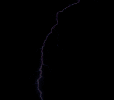
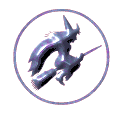

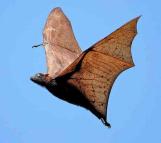
“Suspicions amongst thoughts are
like bats amongst birds, they ever fly by twilight”
Francis Bacon
(1561-1626)
Of all the
creatures associated with the night, perhaps the most misaligned and
misunderstood is the Bat. Fictional
characterisations in modern culture, in movies and on TV, have given the bat an
evil and sinister reputation, but such could not be further from the truth.
In Tonga and ancient Babylonia bats were considered
physical manifestations of the Souls of the Dead.
In China and Poland they were symbols of Happiness and Long life, and to
the ancient Mayans they symbolized Transformation and Rebirth.
So what better time than this Samhain to consider the characteristics and
teachings of the Bat?
Bats are
mammals of the order Chiroptera of which there are 17 families divided into 2
suborders – the larger Megabats and the smaller Microbats.
Only one of these families includes Megabats (of which there are more
than 150 species); the other 16 families are all Microbats containing another
850 species or more. Bats are the only mammals capable of sustained flight,
and are so prolific that the two orders together make up nearly one-quarter of
the world’s mammal population.
Bats
are the most widely distributed group of mammals in the world.
The ability of flight has enabled them to disperse and take up residence
in most all countries, except for the Arctic, the Antarctic and a few isolated
oceanic islands. Bats are more
prolific in warmer countries however, such like Indonesia, home to about 175
species of bats, Venezuela to about 154 and Mexico to some 137. Central and South America is thought to be home to almost one
third of the world’s total bat population.
Sadly, as widely distributed as bats are, some species have drastically
declined and many are now endangered.
The Megabat family includes some
of the largest bats known; one such is the Giant Flying Fox of Africa, India and
Malaysia (so called because of its fox-like face).
The biggest Flying Foxes are found in Java and achieve a wingspan of 1.8
m (6 ft), a body length of 55 cm (22 in) and weigh up to 1.5 kg (3.3 lb).
Flying Foxes are also known as Fruit Bats, because their main diet
consists of fruit and flowers. Of
the Microbat families, the smallest bat is the Kitti’s Hog-nosed bat (also
called the Bumblebee bat), which is found only along the River Kwai in western
Thailand. It measures only 3 cm (1
in) long and weighs about 2 g (0.07 oz), making it one of the smallest mammals
living today.
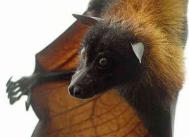
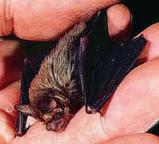
Aside
from their size, Megabats and Microbats are different in many ways.
Megabats have large eyes and mostly fox-like faces; while Microbats have
small eyes and often elaborate facial structures. There is a myth that all bats are blind, but this is not
true. Megabats see relatively well
and rely on smell and vision to find their food, while Microbats have poorer
eyesight and use a unique method of echolocation to orient and detect their food
and prey. Echolocation is a
high-frequency pulsing sound emitted by the bat that bounces back to its ears
from surrounding surfaces thus giving away the location and relative distance of
objects and prey within its environment. It’s
a bit like the way sonar works in submarines.
In this way bats are able to manoeuvre and navigate at night in almost
total darkness.
Bats are the
only mammals capable of true flight. Their
wings consist of a thin, fleshy membrane supported near the leading edge by the
greatly elongated bones of the forelimb and second finger, and towards the tip
and rear by the third, fourth, and fifth fingers.
It is further attached along the bodyline of the trunk and extends back
between the hind limbs and tail. The
thumb of the hand is free and has a sharp hooked claw to help in climbing.
Their feet have five digits or toes, which are also equipped with sharp
hooked claws, but these are used to help suspend the bat upside-down when
roosting.
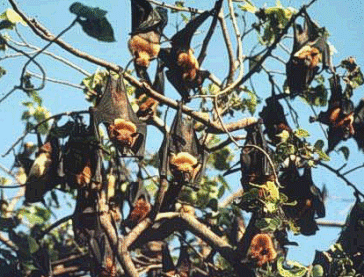
Most all bats are nocturnal.
During the day they roost and rest in a variety of places, but commonly
in dark caves and crevices, hollow trees or in shaded foliage, beneath rocks or
bark and in abandoned buildings. Some
Megabat species in warmer countries roost in more exposed areas where large
colonies of bats can be seen hanging upside down from branches of trees.
Being nocturnal gives bats many advantages, like reduced competition for
insects and other food, freedom from attack by predators, and protection from
overheating during the day which bats are especially susceptible to due to the
size of their wings in relation to their body size. In
countries where winters are cold bats will migrate to warmer climates or
hibernate.
Female bats
birth only one pup a year, which when born clings to the mother bat during
flight and feeds from her milk. After
approximately four months the pup learns to fly on its own.
For many bat species mating takes place before hibernation, during which
time the female stores the sperm in her genital tract throughout the winter and
on awakening in spring uses it to fertilize her eggs.
For their
diets, most Megabats feed on
fruit, flowers, pollen and nectar, while Microbats also feed on insects, fish,
frogs and other small creatures. A
single Microbat can eat something like 3,000 insects in one night, and there is
one species, the Vampire bat, that also feeds on the blood of other mammals.
It is the Vampire bat, perhaps more than any other bat, that is
responsible for fuelling the imagination of writers and film makers with fear
and revulsion, and as a result, given the whole bat population such an evil and
sinister reputation (more on this later).
Bats
perform a vitally important ecological role in nature.
Many rainforest trees depend on bats for pollination and seed dispersal,
which is particularly important in facilitating regrowth after forest
clearances. Similarly, many
tropical plants depend on bats for the distribution of their seeds.
It is estimated there are some 300 bat-dependent plant species yielding
more than 450 economically valuable products.
Some of these products include: Chewing
gum, tequila, sisal, medicines, dyes and fuel.
Even the bat’s waste matter, ‘guano’, is utilized as a valuable
fertilizer. Some bats are the
keystone species on which whole ecosystems depend for their survival.
Perhaps the
most influential source for popularising contemporary fears and dread about bats
was the fictional best selling book called “Dracula” (written by the Irish
author Bram (Abraham) Stoker (1847-1912) and first published in 1897).
In it, he personalized the characteristics
of the Vampire bat into what are now the traditional scary blood sucking Vampire
legends. Such did his book inspire
the imaginations of other writers; it led to a whole plethora of similar stories
and films on the subject.
In truth,
there are only three species of Vampire bats that feed on the blood of other
mammals (usually cattle, horses and large birds such as fowl).
However, despite what popular legend would have us believe, bats do not
suck blood. Bats have very sharp
needlepointed teeth with which they make small incisions on the backs of large
prey, and then lap at the resulting blood droplets.
Most Vampire bats are quite small, commonly only 7 to 9 cm (2.75 to 3.5
in) long, and at best could manage to take only a tablespoon of blood each night
from its prey, hardly enough to cause death by doing so.
One of the
biggest fears people have concerning bats is Rabies. Rabies is a virus transmitted among animals, and sometimes
humans, when bitten by an already infected carrier. However, a study conducted by the University of Florida has
shown less than one-half of 1 percent of all bats have rabies.
So in truth, the conclusion is that a human is more likely to be bitten
by an unvaccinated rabid dog than by a Vampire bat.
Far from being monsters, Vampire bats in general are sociable
creatures, caring towards other members of their colony.
They take part in mutual grooming, and will even take care of another’s
abandoned young when unable to feed, this they do by regurgitating and sharing
the blood they have collected for themselves.
Interestingly,
new medical studies of a clot-dissolving substance found in Vampire bat saliva,
could soon be used to benefit human Stroke victims.
Perhaps
because of their nocturnal habits and ability to navigate in the dark, or simply
because they appear to be both animal and bird at the same time, bats have long
been associated with deity, supernatural forces and the occult.
In the mythologies of differing cultures bats symbolize both good and
evil, life and death. In China many legends associate bats with good fortune.
To them, a group of five bats represented the five causes of happiness:
wealth, health, long life, virtue and a natural death.
In South America among an
ancient Mayan cult of the Quiche, located in the jungles of what is now
Guatemala, Camazotz was a minor deity associated with bats. He was the God of the Caves and is described as having the
body of a human with the head and wings of a bat.
According to the Mayan sacred book of initiation rites Popul Vuh,
he resided in the Bat-house located in the Underworld, a labyrinth of caves
through which huge bats flew. While
legends differ, he was responsible for the seventh test of initiation undertaken
by the Mayan Hero Twins, the
mythical Mayan ruling deities.
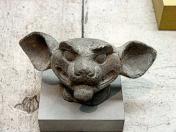
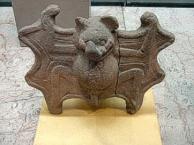
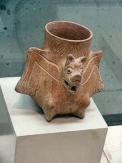
In ancient
Greece and Rome, it was thought that sleep could be prevented either by placing
the engraved figure of a bat under the pillow, or by tying the head of a bat in
a black bag and keeping it near to the left arm. On the Ivory Coast, even today, many think that bats are the
spirits of the dead, and in Madagascar, they are assumed to be the souls of
criminals, sorcerers and the unburied dead.
In medieval Europe, bats were commonly thought to be witches’
familiars. In France 1332, Lady
Jacaume of Bayonne was publicly burned simply because bats were seen to fly
about her house and garden.
Also in
Europe, in the Tyrol regions of Austria, it was believed that if a man wears the
left eye of a bat on his person, he may become invisible, and in areas of
central Germany, if he wears the heart of a bat bound to his arm with red
thread, he will always be lucky at cards. It
was commonly thought that witches used the blood of bats as an ingredient when
making flying ointment, and further, to boost the powers of their magickal brews
and potions. To the Gypsies, who
were equally ostracized as witches, bats were seen as the bearers of good luck;
they even prepared small bags containing dead bat bones for children to wear
around their necks as charms.
In folklore,
to wash your face in bat’s blood will enable you to see more clearly in the
dark. To keep a piece of bat bone
in your pocket will ensure good luck. Powdered
bat’s heart will staunch bleeding or stop a bullet, and bullets from a gun
swabbed with a bat’s heart will always hit their target.
To put bat’s blood into someone’s drink will make him or her more
passionate, and you can stimulate a woman’s desire by placing a drop of bat
blood under her pillow. To prevent
baldness or your hair greying, you should wash the hair in a concoction of
powdered bat wings and coconut oil. The list of folklore concerning bats is endless, and even Shakespeare
got in on the act. In his famous
play Macbeth, he had his three witches adding “wool of bat” to their
hellbroth, and in The Tempest (Act I, Scene 2) he had Caliban place
a curse on his master Prospero, which included the line: “All the charms of
Sycorax, toads, beetles, bats, light on you!”
The bat as a
totem animal is a symbol representative of transition and rebirth.
A bat appearing in your life could mean that some aspect of your life is
coming to an end, and rather than fear the change, you should embrace the
transition and look forward to some kind of new beginning.
It's a time for serious self-examination and self-evaluation.
This may sound easy to do, but for most people change is a frightening
experience. Bat’s appearance is
there to help you soar above your fears by getting rid of those things in your
life that are no longer needed. Only
by facing the darkness of your uncertainties can you progress and find light in
new beginnings.
To many
misinformed people, the bat is a symbol of death, but try to embrace the
positive powers of the bat. Bats
typically live in deep underground caves, which symbolically is the belly of the
Mother (Earth), and from these womb-like caves they emerge each evening at dusk
- reborn. To a shaman the
appearance of a bat does not signify actual or physical death, but more the
death of old fears or the old ways of doing things that no longer serve you.
By learning from the bat you can fly through any darkness into the light,
be transformed, re-born and free.
“For as the eyes of bats are to the blaze of day, so is the reason in our soul to the things which are by nature most evident of all” - Aristotle (384-322 BC).
![]()
Penguin
Hutchinson Reference Library Copyright (c) 1996 Helicon Publishing and
Penguin Books Ltd
Microsoft
® Encarta ® 2006. © 1993-2005 Microsoft Corporation. All rights reserved.
Animal-Speak
(The Spiritual & Magical Powers of Creatures Great & Small) - By Ted
Andrews
Man,
Myth and Magic -
Edited by Richard Cavendish
Plus to many
websites to mention.
![]()
![]()

Let there be peace in the world - Where have all the flowers gone?
My Personal Page / My Place in England, UK / My Family Tree (Ancestry)
Wicca/Witchcraft / What is Wicca / What is Magick
Traditional Writings:
Wiccan Rede / Charge of the Goddess / Charge of the God / The Three-Fold Law (includes The Law of Power and The Four Powers of the Magus) / The Witches Chant / The Witches Creed / Descent of the Goddess / Drawing Down the Moon / The Great Rite Invocation / Invocation of the Horned God / The 13 Principles of Wiccan Belief / The Witches Rede of Chivalry / A Pledge to Pagan Spirituality
Correspondence Tables:
Incense / Candles / Colours / Magickal Days / Stones and Gems / Elements and Elementals
Traditions Part 1 - Alexandrian Wicca / Aquarian Tabernacle Church (ATC) / Ár Ndraíocht Féin (ADF) / Blue Star Wicca / British Traditional (Druidic Witchcraft) / Celtic Wicca / Ceremonial Magic / Chaos Magic / Church and School of Wicca / Circle Sanctuary / Covenant of the Goddess (COG) / Covenant of Unitarian Universalist Pagans (CUUPS) / Cyber Wicca / Dianic Wicca / Eclectic Wicca / Feri Wicca /
Traditions Part 2 - Gardnerian Wicca / Georgian Tradition / Henge of Keltria / Hereditary Witchcraft / Hermetic Order of the Golden Dawn (H.O.G.D.) / Kitchen Witch (Hedge Witch) / Minoan Brotherhood and Minoan Sisterhood Tradition / Nordic Paganism / Pagan Federation / Pectic-Wita / Seax-Wica / Shamanism / Solitary / Strega / Sylvan Tradition / Vodoun or Voodoo / Witches League of Public Awareness (WLPA) /
Gods and Goddesses (Greek
Mythology) / Esbats &
Full Moons / Links
to Personal Friends & Resources / Wicca/Witchcraft
Resources / What's a spell? /
Circle Casting and
Sacred Space / Pentagram
- Pentacle / Marks
of a Witch / The Witches
Power / The Witches Hat
/ An
esoteric guide to visiting London / Satanism
/ Pow-wow
/ The
Unitarian Universalist Association / Numerology: Part 1
/ Part 2 / Part
3 / A
history of the Malleus Maleficarum: includes: Pope
Innocent VIII /
The
papal Bull /
The
Malleus Maleficarum /
An extract from the Malleus Maleficarum
/ The letter of approbation
/ Johann
Nider’s Formicarius /
Jacob
Sprenger /
Heinrich Kramer /
Stefano Infessura
/ Montague Summers /
The Waldenses
/ The Albigenses
/
The Hussites / The
Sun Dance
/ Shielding (Occult
and Psychic Protection) /
Sabbats in History and Mythology / Samhain (October 31st) / Yule (December 21st) / Imbolc (February 2nd) / Ostara (March 21st) / Beltane (April 30th) / Litha (June 21st) / Lughnasadh (August 1st) / Mabon (September 21st)
Rituals contributed by Crone: Samhain / Yule / Imbolc / Ostara / Beltane / Litha / Lammas / Mabon
Tools of a Witch / The Besom (Broom) / Poppets and Dolls / Pendulums / Cauldron Magick / Mirror Gazing
Animals in Witchcraft (The Witches Familiar) / Antelope / Bats / Crow / Fox / Frog and Toads / Goat / Honeybee / Kangaroo / Lion / Owl / Phoenix / Rabbits and Hares / Raven / Robin Redbreast / Sheep / Spider / Squirrel / Swans / Wild Boar / Wolf / Serpent / Pig / Stag / Horse / Mouse / Cat
In Worship of Trees - Myths, Lore and the Celtic Tree Calendar. For descriptions and correspondences of the thirteen sacred trees of Wicca/Witchcraft see the following: Birch / Rowan / Ash / Alder / Willow / Hawthorn / Oak / Holly / Hazel / Vine / Ivy / Reed / Elder. Also see: The Willow Tree (Folk Music)
Mystical Sacred Sites - Stonehenge / Glastonbury Tor / Malta - The Hypogeum of Hal Saflieni / Avebury / Cerne Abbas - The Chalk Giant / Ireland - Newgrange /
Rocks and Stones:
Stones - History, Myths and Lore
Articles contributed by Patricia Jean Martin: / Apophyllite / Amber / Amethyst / Aquamarine / Aragonite / Aventurine / Black Tourmaline / Bloodstone / Calcite / Carnelian / Celestite / Citrine / Chrysanthemum Stone / Diamond / Emerald / Fluorite / Garnet / Hematite / Herkimer Diamond / Labradorite / Lapis Lazuli / Malachite / Moonstone / Obsidian / Opal / Pyrite / Quartz (Rock Crystal) / Rose Quartz / Ruby / Selenite / Seraphinite / Silver and Gold / Smoky Quartz / Sodalite / Sunstone / Thunderegg / Tree Agate / Zebra Marble
Wisdom:
Knowledge vs Wisdom by Ardriana Cahill / I Talk to the Trees / Awakening / The Witch in You / A Tale of the Woods
Articles and Stories about Witchcraft:
Murder by Witchcraft / The Fairy Witch of Clonmel / A Battleship, U-boat, and a Witch / The Troll-Tear (A story for Children) / Goody Hawkins - The Wise Goodwife / The Story of Jack-O-Lantern / The Murder of the Hammersmith Ghost / Josephine Gray (The Infamous Black Widow) / The Two Brothers - Light and Dark
Old Masters of Academia:
Pliny the Elder / Hesiod / Pythagoras
Abramelin the Mage / Agrippa / Aidan A. Kelly / Albertus Magnus “Albert the Great” / Aleister Crowley “The Great Beast” / Alex Sanders "the King of the Witches” / Alison Harlow / Amber K / Anna Franklin / Anodea Judith / Anton Szandor LaVey / Arnold Crowther / Arthur Edward Waite / Austin Osman Spare / Biddy Early / Bridget Cleary / Carl Llewellyn Weschcke / Cecil Hugh Williamson / Charles Godfrey Leland / Charles Walton / Christina Oakley Harrington / Damh the Bard (Dave Smith) / Dion Fortune / Dolores Aschroft-Nowicki / Dorothy Morrison / Doreen Valiente / Edward Fitch / Eleanor Ray Bone “Matriarch of British Witchcraft” / Dr. John Dee and Edward Kelly / Dr. Leo Louis Martello / Eliphas Levi / Ernest Thompson Seton / Ernest Westlake and the Order of Woodcraft Chivalry / Fiona Horne / Friedrich von Spee / Francis Barrett / Gerald B. Gardner / Gavin and Yvonne Frost and the School and Church of Wicca / Gwydion Pendderwen / Hans Holzer / Helen Duncan / Herman Slater "Horrible Herman" / Israel Regardie / James "Cunning" Murrell / Janet Farrar & Gavin Bone / Jessie Wicker Bell “Lady Sheba” / John Belham-Payne / John George Hohman / John Gerard / John Gordon Hargrave (the White Fox) / John Michael Greer / John Score / Johannes Junius the Burgomaster of Bamberg / Joseph John Campbell / Karl von Eckartshausen / Laurie Cabot "the Official Witch of Salem" / Lewis Spence / Margaret Alice Murray / Margot Adler / Marie Laveau the " Voodoo Queen of New Orleans" / Marion Weinstein / Matthew Hopkins “The Witch-Finder General” / Max Ehrmann and the Desiderata / Monique Wilson the “Queen of the Witches” / Montague Summers / Nicholas Culpeper / Nicholas Remy / M. R. Sellers / Mrs. Grieve "A Modern Herbal" / Oberon and Morning Glory Zell-Ravenheart / Old Dorothy Clutterbuck / Old George Pickingill / Paddy Slade / Pamela Colman-Smith / Paracelsus / Patricia Crowther / Patricia Monaghan / Patricia “Trish” Telesco / Philip Emmons Isaac Bonewits / Philip Heselton / Raymond Buckland / Reginald Scot / Robert Cochrane / Robert ‘von Ranke’ Graves and "The White Goddess" /
Rudolf Steiner / Rosaleen Norton “The Witch of Kings Cross” / Ross Nichols and The Order of Bards, Ovates & Druids / Sabrina - The Ink Witch / Scott Cunningham / Selena Fox / Silver Ravenwolf / Sir Francis Dashwood / Sir James George Frazer / S.L. MacGregor Mathers and the “Hermetic Order of the Golden Dawn” / Starhawk / Stewart Farrar / Sybil Leek / Ted Andrews / The Mather Family - includes: Richard Mather, Increase Mather, Cotton Mather / Thomas Ady / Vera Chapman / Victor Henry Anderson / Vivianne Crowley / Walter Brown Gibson / William Butler Yeats / Zsuzsanna Budapest
Many of the above biographies are brief and far from complete. If you know about any of these individuals and can help with aditional information, please cantact me privately at my email address below. Many thanks for reading :-)
While I have taken due care and dilligence to credit all sources where possible, this website may contain copyrighted material which has not been specifically authorized by the copyright owner. My use of making such material available here is done so in my efforts to advance our understanding of religious discrimination, the environmental and social justice issues etc. If you wish to use copyrighted material from this wedsite for purposes of your own then you must obtain permission from the relevant copyright owner yourself.
![]()
My online email discussion group:
http://groups.yahoo.com/group/Email_Witches

Help send a message of peace around the world! The Dove of Peace flies from site to site, through as many countries as possible. It does not belong to ANY belief system. Please help make a line around the globe by taking it with you to your site, by giving it to someone for their site, by passing it on to another continent or to the conflict areas of the world. May trouble and strife be vanquished in it's path.

mailto:George@controverscial.com
![]()
|
|